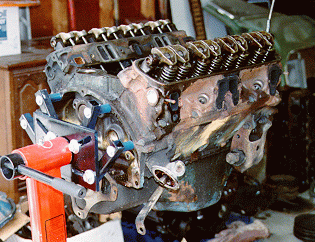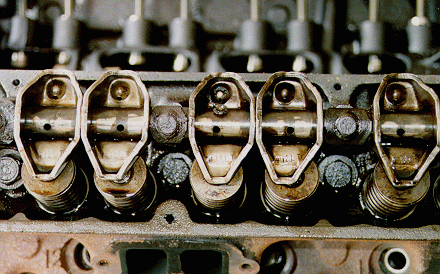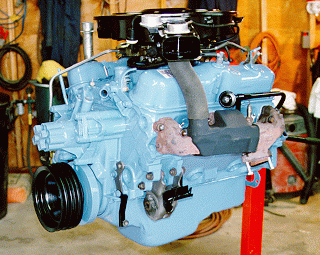 With the passing of winter, I had
several projects I hoped to complete over the summer. I pushed the Imperial
back on the schedule in order to complete a 460 ford motor that was eager to
stop taking up space in my garage. It was already July when I decided to
bring the Imperial out of storage and start working on it. With all of the
obvious problems the engine had, that seemed the logical place to start.
With the passing of winter, I had
several projects I hoped to complete over the summer. I pushed the Imperial
back on the schedule in order to complete a 460 ford motor that was eager to
stop taking up space in my garage. It was already July when I decided to
bring the Imperial out of storage and start working on it. With all of the
obvious problems the engine had, that seemed the logical place to start.
In a fairly short amount of time, I had the engine hoisted out of the car
and ready for a thurough inspection. I didn't even have it bolted to the
stand before I realized what some of the problems were. The engine was
losing a large amount of oil from the front crankshaft seal and coolant was
leaking from nearly all the engine core plugs. I continued to disassemble
the engine and see was other suprises it had to reveal.
Besides the replacement of the fuel injection, it was obvious that other work
had been done to the engine along the way. The right cylinder head had
obviously been off the car before, but the left seemed to be undisturbed.

This picture shows the engine shortly after I removed it from the car.
If you look closely, there is evidence of coolant leakage from the right
head gasket, and the core plugs. In fact, six of the eight core plugs in
the block were rusted and leaking a fair amount of coolant.
As I went deeper in the teardown, I was horrified to discover what was
waiting for me on the right cyliner head. The picture below tells the
story:

See if you can spot all of what is wrong in this picture.
Click on it to see the answers.
After it became obvious that a Briggs & Straton mechanic (no offense to
Briggs) had done a tremendous amount of injustice to this engine, I decided
to remove the heads and see what else lay ahead. I am fairly used to
removing head bolts, and having just finished a rebuild on a 460 Ford motor
with head bolts torqued at 130 lb/ft, I was more than prepared. Armed with my
trusty breaker bar and an 18 inch piece of PVC pipe for a little added
leverage, I braced the engine stand with my foot. All prepared to break
the first bolt loose, I nearly fell over backwards as I discovered that the
bolt was not anywhere near the correct torque. With a little less force, I
decided to try some of the other head bolts. Although I souldn't have been
surprised in light of the other work that had been done to this engine, I
found that none of the head bolts were much more than hand tight. This
would certianly explain the coolant leak from the head gasket.
After discovering all the problems with the right cylinder head, I
started to remove the left one. The left side appeared to have never been
off. This proved to be right as I discovered the orginal Chrysler head
gasket was still in place. After taking a closer look at the heads off the
car, I could clearly see that the right head was a recently rebuilt one and
the left was in need of rebuilding. It seemed odd that someone would take a
fairly high milage engine apart enough to replace the right head and never
touch the left one.
After getting the ramainder of the engine's internals removed, I started
cleaning up the block. As I removed the rotted core plugs, I discovered
that previous owners had been dumping radiator stop leak into the cooling
system for quite some time. The bottom of the water jackets were full of
black goo and scale from never flushing the cooling system.
From this point on, the engine work was fairly routine and went back
together as easily as most small block Mopar engines. I was quite happy to
find a stainless steel replacement for the air pump tubing at the rear of
the engine. Most everything else that came off the engine was in good
shape. All that remained after getting it back together was to give it a
good coat of Mopar blue engine paint to make it look better than new.

Having the engine out of the car provided me with a great opportunity to
clean-up and repair some of the other under-hood problems. The car had
88,000 miles on it by this time and had some fairly worn suspension
components. I replaced upper ball joints and torsion bar pivot bushings
along with doing all the front brakes. All four shock absorbers were the
orginal units, all very much in need of replacement. This is where you
appreciate the fact that the 81-83 Imperials share the same suspension as
all J and M body Chrysler products.
 Go on to the next page,
Go on to the next page,
 or return to the main page.
or return to the main page.
 With the passing of winter, I had
several projects I hoped to complete over the summer. I pushed the Imperial
back on the schedule in order to complete a 460 ford motor that was eager to
stop taking up space in my garage. It was already July when I decided to
bring the Imperial out of storage and start working on it. With all of the
obvious problems the engine had, that seemed the logical place to start.
With the passing of winter, I had
several projects I hoped to complete over the summer. I pushed the Imperial
back on the schedule in order to complete a 460 ford motor that was eager to
stop taking up space in my garage. It was already July when I decided to
bring the Imperial out of storage and start working on it. With all of the
obvious problems the engine had, that seemed the logical place to start.



 Go on to the next page,
Go on to the next page, or return to the main page.
or return to the main page.